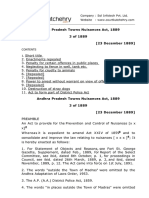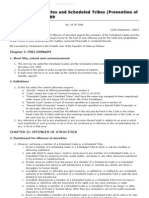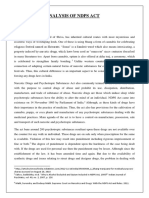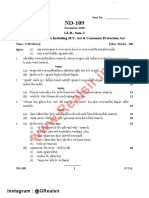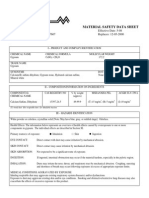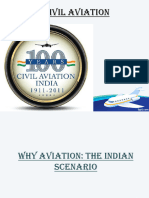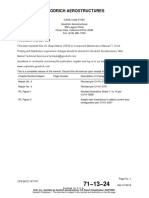IPR
WHAT IS IPR?
Intellectual property rights are the rights given to persons over the creations of their minds. They usually
give the creator an exclusive right over the use of his/her creation for a certain period of time.
IPRs in India are administered by the Department of Industrial Policy and Promotion under the
Ministry of Commerce & Industry.
TYPES OF IPR
Patent
A patent is granted for an invention which is a new product or process that meets conditions of
novelty, non-obviousness and industrial use.
Novelty means inventive step is the feature(s) of the invention that involves technical advance as
compared to existing knowledge.
Non-obviousness means the invention is not obvious to a person skilled in the art.
Industrial use means that the invention is capable of being made or used in an industry.
Patents in India are governed by “The patent Act 1970” which was amended in 2005 to make it
compliant with TRIPS.
Trademark
A trademark means a mark capable of being represented graphically and which is capable of
distinguishing the goods or services of one undertaking from those of other undertakings.
A Trade Mark can be a device, brand, heading, label ticket name, packaging, sign, word, letter, number,
drawing, picture, emblem, colour or combination of colours, shape of goods, signature or a combination
thereof.
Trade marks in India are governed by Trade Marks Act 1999 which was amended in 2010.
Geographical Indications
It is a sign used on agricultural or natural or manufactured goods as originating or manufactured in a
particular region of a country. It denotes its origin where a specific quality, characteristic or
reputation of the product is essentially attributable to that origin.
Geographical Indicators in India are governed by “The Geographical Indications of Goods
(Registration & Protection) Act, 1999”.
GI OF RAJASTHAN- Kota Doria ,Maheshwar Sarees & Fabric, Molela Clay Work of Rajasthan , Blue
Pottery of Jaipur , Kathputlis of Rajasthan ,Makrana Marble, Thawa Art Work (Gold Work on Glass),
Kota Doria , Bagru Hand Block Print, Sanganeri Hand Block Print, Bikaneri Bhujia, Kathputlis of
Rajasthan, Molela Clay Work, Blue Pottery of Jaipur, Phulkari,
Copyright
Copyright is a right given by the law to creators of literary, dramatic, musical and artistic works and
producers of cinematograph films and sound recordings.
This right allows its creator the rights of reproduction, communication to the public, adaptation and
translation of the work.
Copyrights in India are governed by “The Copyright Act, 1957”.
Design
An industrial design consists of the creation of a shape, configuration or composition of pattern or color,
or combination of pattern and color in three-dimensional form containing aesthetic value.
An industrial design can be a two- or three-dimensional pattern used to produce a product, industrial
commodity or handicraft.
Designs in India are governed by “The Designs Act 2000”.
1
�Plant Variety Protection
It refers to the protection granted for plant varieties. These rights are given to the farmers and plant
breeders to encourage the development of new varieties of plants.
Plant variety protection in India is governed by “The Protection of Plant Varieties and Farmers’
Rights (PPV&FR) Act, 2001”.
NATIONAL IPR POLICY 2016
The new IPR policy to be unveiled will be completely compliant with the World Trade Organization’s
agreement on Trade Related aspects of IPRs (TRIPS).
The policy will have a special thrust on
Awareness generation at school/college level,
Effective enforcement of IPRs and
Encouragement of IP commercialization through various incentives
The policy will retain the provisions on Compulsory Licensing (CL) (in the National Manufacturing
Policy and Section 84 of India's Patents Act) as well as Section 3(d) of India's Patents Act (preventing
ever-greening of drug patents) in spite of the EU and US objections terming CL as inconsistent with
WTO’s TRIPS agreement.
According to Section 3(d), besides novelty and inventive step, improvement in therapeutic efficacy is a
must for grant of patents when it comes to incremental inventions.
The policy will also suggest incentives such as tax benefits and fee waivers to encourage R&D and
IP creation to strengthen the Make In India/Start-up/Digital India initiatives.
To protect 'small inventions' developed especially in the informal / unorganized sectors, policy will
promote ‘utility patents’ (with lower compliance burden and shorter period of protection, when
compared to the normal patents) only for mechanical innovations.
Seven objectives
IPR Awareness - To create public awareness about the economic, social and cultural benefts of IPRs
among all sections of society.
Generation of IPRs - To stimulate the generation of IPRs.
Legal and Legislative Framework - To have strong and effective IPR laws, which balance the interests
of rights owners with larger public interest.
Administration and Management - To modernize and strengthen service oriented IPR administration.
Commercialization of IPR - Get value for IPRs through commercialization.
Enforcement and Adjudication - To strengthen the enforcement and adjudicatory mechanisms for
combating IPR infringements.
Human Capital Development - To strengthen and expand human resources, institutions and capacities
for teaching, training, research and skill building in IPRs.
Key features
Department of industrial policy and promotion (DIPP) will be the nodal agency for all IPR issues.
Films, music, industrial drawings will also come under the ambit of copyright.
Existing IPR laws will be reviewed to remove any inconsistencies and make them in accordance with
present time and future needs.
Less empowered groups of IP owners such as artisans, weavers and farmers will be provided financial
support by offering them IP friendly loans.
Trademark offices to be modernised, and the aim is to reduce the time taken for examination and
registration to just 1 month by 2017.
It proposes to establish IP Promotion and Development Council which will oversee opening of IP
Promotion and Development Units in all states in order to create a single window system for promotion,
awareness and utilization of IP in the country.
1st time patent fee waiver and a support system for MSMEs. This will boost innovation in the sector.
Also an effective loan guarantee scheme to be created to encourage start-ups.
The policy to be reviewed every 5 years in consultation with all the stakeholders.
2
�Limitations
The policy is based on the premise that more IPRs mean more innovation. However there is little
research that backs this assumption.
Openness, sharing and access to knowledge have been given back seat in the policy document.
Policy suggests researchers in public funded research organizations to mandatorily convert all research
into IP. However it is best left at the discretion of the inventor.
Criminalizing the civil wrong of unauthorized copying such as movies and literature is prone to misuse.
To create an atmosphere of creativity and innovation, a holistic approach is required and not just IPR
protection.
Conclusion and way forward
The Policy aims to push IPRs as a marketable financial asset, promote innovation and entrepreneurship,
while protecting public interest including ensuring the availability of essential and life-saving drugs at
affordable prices.
The new IPR policy introduced with a slogan of “Creative India, Innovative India” is largely a step in
the right direction. However to obtain the best outcome the challenges and limitations needs to be
suitable addressed.
INTERNATIONAL AGREEMENTS AND BODIES
TRIPS Agreement
Trade-Related Aspects of Intellectual Property Rights is an international agreement administered by
WTO that sets down minimum standards for IP regulation for WTO member nations.
TRIPS contain provisions that allow a degree of flexibility and sufficient room for countries to
accommodate their own patent and intellectual property systems and developmental needs.
A balance between the goal of providing incentives for future inventions of new drugs and the goal of
affordable access to existing medicines is one such flexibility.
India amended its IPR laws such as the Patent Act of 1970 was amended in 2005 to make it compliant
with this agreement.
Marrakesh Treaty
It is to facilitate access to published works for persons who are blind, visually impaired, or otherwise
print disabled.
This treaty provides an exception to domestic copyright law for visually impaired and print disabled
people.
This means that countries which ratify the treaty must ensure their laws allow blind people and their
organisations to make accessible format books without the need to ask permission first from the holder
of copyright (e.g. author or publisher).
India was the first country to ratify the Marrakesh Treaty.
Berne Convention
It is an international agreement governing copyright which came into being in 1886.
It provides for the protection of literary and artistic works.
It established a system of equal treatment for internationalised copyright amongst signatories.
It provides creators such as authors, musicians, poets, painters etc. with the means to control how their
works are used, by whom, and on what terms.
WIPO
It was created in 1967 to encourage creative activity and promote the protection of intellectual property
throughout the world.
It is one the 17 specialized agencies of the UN.
Apart from promoting creative intellectual activity and for facilitating the transfer of technology related
to industrial property to the developing countries in order to accelerate economic, social and cultural
development.
3
� IPR ISSUES IN INDIA
IPR ISSUES BETWEEN INDIA AND THE US
US is a big critique of India’s IPR environment and has put her on “Priority watch list” of special 301
report. US accuse India of doing minimum to protect patent laws on global level.
This and other retaliatory measures taken by USA to protect its corporates are a clear violation of the
WTO's principles. India has sent a strong message by rejecting all accusation and challenged the USA to
justify its measures in WTO.
Major contentious issues are:
Section 3(d) of the Patent Act 1970 which prevents ever greening of the patent and requires
efficacy improvement for re-patent. Example: this led to cancellation of the patent for Novartis AG's
cancer drug Glivec.
Section 84 of the Patent Act which provides for compulsory licensing. This empowers the
government to allow manufacture of patented product without the prior permission of patent holder
in the larger public interest. Example: Indian company Natco phar3ma in 2012 to manufacture
cancer drug nexavar and sell it at a very low price.
The step taken by government considering the importance of public health was fully compatible with
TRIPs and well within the boundaries of its patent laws.
ISSUE OF PATENTS AND INDIAN GENERIC MEDICINE
Background
USA and European Union have time and again raised issues over Indian Patent Laws.
2 provision have been sighted as problematic by western drug manufacturers -
Section 3(D) of the Indian Patents Act, which checks “ever greening” of Patents on frivolous
grounds.
Compulsory Licensing (CL): allowing someone else to produce the patented product or process
without the consent of the patent owner.
SC of India has ruled against ever-greening of a drug- Glivec by Novartis and India has also issued CL
for cancer drug Nexavar to issue generic medicines.
So, the Office of United States Trade Representative has put India into “Priority Watch list”(PWL) in
its Annual Special 301 report.
What do WTO rules say?
Indian patent laws are compliant with TRIPS (Trade Related Aspects of Intellectual Property Rights).
It allows flexibilities to governments to issue compulsory licensing in case the original manufacturer
reverts to anti-competition policy or in the interest of public health.
Current Issue
India is in the process of formulating its maiden IPR policy and it is alleged that U.S. industry lobby
groups such as the U.S.-India Business Council (USIBC) and U.S. Chamber of Commerce received
verbal, private assurances from Indian officials that India will not use ‘compulsory licensing’.
USIBC also revealed that it had conducted “trainings” for India’s patent examiners which might affect
independence of patent examination system.
Concerns for India
Affects India’s status of “pharmacy of the world”
Threaten people’s accessibility to medicines.
Affect India’s fight against Drug Resistant TB, HIV, Cancer etc.
Erode our Soft power especially with African countries for which India is the source of low cost generic
lifesaving medicines.
Way out
Resist pressure from the lobbyist group and ensuring that new IPR Policy is TRIPS compliant.
Utilize flexibilities in international rules to cater to health needs of least developed and developing
countries.
To take like-minded countries on board on international forums over the issue.
4
�BIOPROSPECTING AND BIOPIRACY
Biopiracy is the practice of commercially exploiting naturally occurring biochemical or genetic material, especially
by obtaining patents that restrict its future use, while failing to pay fair compensation to the community from which it
originates.
Introduction
Bioprospecting refers to biodiversity prospecting. It is the process of discovery and
commercialization of new products based on biological resources.
These biological resources may include chemical compounds, genes, micro-organisms, macro-
organisms, and other valuable products from nature.
Analysis
Pros:
Bio-prospecting, if well managed, can generate income for developing countries and its
indigenous community.
It can provide incentives for the conservation of biological resources and biodiversity.
It can lead to discovery of new drugs.
Cons:
If not well managed, bioprospecting may lead to environmental problems related to unauthorized
(over-) exploitation.
Social and economic problems related to unfair sharing of benefits -or the total absence of benefit
sharing- and to disrespect for the rights, knowledge and dignity of local communities.
Thus bioprospecting in itself is not bad. However it is its misuse (leading to biopiracy) that creates
problem for nature and human kind.
Steps taken to prevent biopiracy
India is a member of CBD (Convention on Biodiversity) and as a mark of its ratification, India enacted
the Biodiversity Act of 2002.
Autonomous bodies such as National biodiversity authority, state biodiversity boards and biodiversity
management committees have been constituted to regulate access to biological resources and associated
traditional knowledge to ensure equitable sharing of benefits arising out of their use.
Traditional knowledge digital library: It is a database that documents traditional knowledge and
makes it available in the public domain.
Way forward
It is evident that India is on the right path when it comes to protecting its national interest in its
biodiversity and traditional knowledge, while granting access on a case-by-case basis.
The issue of benefit sharing is tantamount, and India must now adopt a balanced approach to safeguard
its genetic resources while promoting much needed growth in the biotechnology sector.
This could be achieved by formulating a comprehensive National Bioprospecting Policy which
suitably addresses issues related to intellectual property rights, tenure of land and natural resources,
R&D, conservation and protection of biodiversity.












